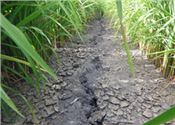|
Producers Explain Benefits Of New Rice Growing System
STONEVILLE, MISS.
Alternating wet and dry production is a radical new way to grow rice, and some Mississippi producers are finding the idea not only seems feasible in theory, but also works well in practice.
Jason Krutz is an irrigation specialist with the Mississippi State University Extension Service and a researcher with the Mississippi Agricultural and Forestry Experiment Station. He said the technique, known as AWD, grows rice without standing water, which reduces water use by about a third while also maintaining yields.
“The economic advantage we have seen in our research and on-farm situations is that AWD fields come in about $50 ahead per acre from water savings,” Krutz said. “AWD rice fields use an initial flood for two weeks to get the crop established and then allow water to subside to 4 inches below the soil surface before refilling to the recommended 2- to 4-inch flood.”
Krutz said the technique repeats this sequence of wet and dry until the field is drained for harvest. Rice is very sensitive to drought stress during flowering, so a 2- to 4-inch flood is maintained for a week at this time before the AWD cycle is resumed.
“Our experience with alternating wet and dry production shows us that we can grow rice without a continuous flood, and the benefits seem to outweigh the negatives,” Krutz said. “AWD may not be ideal for every situation on every field, but it is a money saver on many fields.”
Carter Murrell, a partner in Murrell Farms in Avon, is one producer who adopted AWD in 2013. His family has been growing rice in Washington County since the early 1950s. Today, they farm between 600 and 700 acres, all grown by alternating wet and dry management.
“We saw no change in yields when we switched to AWD rice,” Murrell said. “In any given year, we’re using from 16 to 23 acre-inches of water, but we were using 20 to 25 percent more than that with traditional rice management.”
Murrell said weed control was a big concern when moving to the new management style.
“We were always taught that growing rice in flooded conditions was for weed control, but we found that by the time the actual alternating wet and dry process begins, we had enough shade in the crop to keep the weeds under control,” he said.
Murrell said the growing method has saved him money, and he plans to keep using AWD on his farm. He recommended other rice farmers consider it on their fields.
“If you’re willing to try, start with small steps as your comfort level allows, and you will see the benefit in those small steps,” Murrell said. “Let the water down some, even if you’re not comfortable in going to a full mud state. If you’re not utilizing multiple inlet irrigation, start there and work forward.”
David Arant Sr., a partner in Arant Acres in Ruleville, farms in Leflore County. 2016 was the first year he tried AWD on his rice fields.
“I tried it on a limited basis to see how it would do,” Arant said. “A lot of our land is precision graded, and a lot is zero graded. We’ve always watered the conventional way, but I had three fields that we tested on last year.”
Arant’s crop consultant managed one field with AWD, Arant managed another field with side-inlet irrigation, and he managed the third field using conventional flood practices. Both the AWD field and the side-inlet irrigated field used less water than normal, and the AWD field had the highest yield of all three test fields.
“The yield monitor on the combine showed it yielded four bushels more than the field I managed and six more bushels than the conventional management field,” Arant said. “We used all the same variety, planted at the same time and cut at the same time with the same combine to get these results.”
Arant said he might use AWD on more acreage this year. Dealing with polypipe for irrigation is the only drawback Arant identified, but he said placing the piping is a challenge on any field.
“I’d recommend the AWD program to anybody,” Arant said. “We’re trying to be more conservation minded to save our water, and this can be a good way to do that.” ∆

Alternating wet and dry rice production systems allow rice fields to dry to several inches below the
surface before adding more water. Research shows such fields maintain yields while
cutting water use dramatically.
|
|